Solitary bees
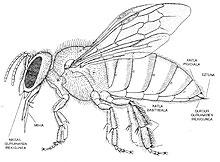
Solitary bees perform one of the most important tasks in ecological systems, especially in the pollenization of planted and wild plants. In fact, in some regions of the world, farmers have begun to take steps to adapt solitary bees for pollenization of crop plants, as alfalfa crop plants are not well pollenated by honey bees.
It seems that bees, clay wasps and other solitary wasps evolved in the middle of the Cretaceous Age (100 million years ago) when angiosperm plants became the main vegetation of the Earth. Today, bees live anywhere, although the greatest abundance and diversity of species occurs in semi-dry and warm temperate climates. The overall appearance of many solitary bees is more like wasp, fly and cornice than hive.
Its length ranges from 1.5-46 mm. Some species have no hair and are bright. Others are very hairy. Although some have an ugly appearance, there are others very pretty, like the bees of green orchids. On the hair or on stains and ribbons appear all colors of the rainbow.
Solitary bees can be divided into 9 families: colítido, Andrénido, Halíctido, Megacílido, Antofosrido, Melítico, Oxeido, Fidelido and finally, Apido.
Construction of the house
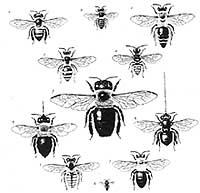
The nest and incubation cells of the solist bees are built in the subsoil, especially in the dry, bare and loose soil that remains in the morning sun. In these habitats also inhabit ants and solitary wasps that are relatives of bees. In the right areas you can find congregations of solitary bees with terrestrial customs, composed of thousands of nests.
Females do not participate in the construction of the nest, even if it seems strange to us. The largest known nesting congregation occupied some 360,000 square meters along the Barysh River in the Soviet Union. Colletes Thoracicus is the membranous bee responsible for these problems, whose adult active life is usually about six weeks.
The bees that nest on the pavement have a large space to build their own living quarters. But throughout most of the year, the supply of honey and pollen that have been collected for the feeding of the offspring is met with the Ara-zu to protect themselves from soil moisture and the numerous edaphic organisms (bacteria, yeasts, fungi, nematodes and mites).
Most of the bees that inhabit the pavement cover the underground incubation cells with waterproof deposits before supply. These bees have an open abdominal gland (Dufour Gland) near the punch. In some species it can constitute almost half of the abdominal cavity. The gland hides a fatty liquid with mucus scent. A few species collect resins or leaf fragments from plants to cover incubation cells. Faithful and bees that only inhabit the deserts do not cover the slow.
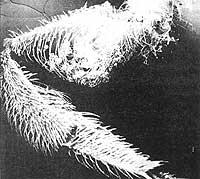
Most solitary bees have the following activity: they fly by day collecting food, put an egg in the afternoon (then a sealed pile), at dusk induce a new calm and at night apply the secretion of the Dufour gland. The new pile will be dry and ready to accept the rations the next morning. These bees work day and night, almost without problems.
Bees that do not live in the subsoil do not need to protect their offspring from moisture, and probably for that reason, they have a fairly small Dufour gland. Most megacids use existing holes or nests (usually located on the ground) and build the incubation cells with mud, resin or vegetable thread, or with precisely cut leaves and petals.
Combat attacks
Most solitary bee females can defend themselves as honey bee and bumblebee by puncturing, but their poison is not usually violent. Nests of solitary bees, unless very stacked, do not attract vertebrate remains to their scarce supplies. Therefore, bees have not developed a typical punch attack.
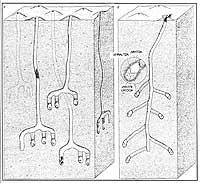
However, nests of solitary bees suffer mainly from attacks by microorganisms and invertebrates. Bees have also developed mechanisms to overcome these aggressions. Fungi are the main enemies of solitary bees that nest in the ground. The bee has to work with desire to finish the preparation of the portions and put the egg so that before the larva to be formed the food will be wasted.
The system works well if there is not much yeast and bacteria in between foods. Normally, these microorganisms present in the floral nectar accumulate with supplies. But an excessive concentration of sugars limits its growth. In solitary bees, according to what happens in honey bees, the excess water of honey evaporates as the nectar of the flowers becomes honey, with the help of enzymatic reactions.
For a long time it was thought that these bees supplied in groups had no more relationship with the offspring. However, when the contents of a pile are contaminated with a fungus, the mother bee opens the stack and accumulates the soil. This procedure reduces the air useful for mushroom cultivation and prevents infection of the side cells. Although some species that inhabit the Earth may lose almost half of their descendants each year due to fungal infection, nesting species of wood, trunks and cloths are not usually attacked.
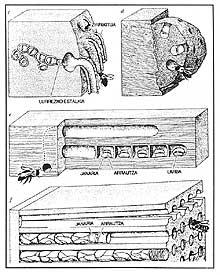
The solitary bee should spend several hours a day away from the nest in collecting nectare or pollen. At that time, the promise forsaken is very aggressive. Incubation cells of some species appear, hermetically closed with resins, secretions or clay lids. For their part, the inertized of other species have a permeable cover of firm earth, leaf or sawdust. The mother bee can protect its nest by accumulating land at the entrance while outside. However, the laying of solitary bees is affected by animal residue and by the cause of parasites, such as wasps, ants, flies, beetles, mites and nematodes.
Males looking for females
The males of the solitary bees leave the pupa a few days before the females of the same species. They eat nectare of flowers and pollen and from the egg they look for daring virgin females. In some species, males form groups, acting as patrols in the vicinity of the place of residence or in the flowers usually visited by females. When males see a female or similar object, they also jump it, but if there is no ferormon in the environment, they leave it immediately.
When a virgin female appears, all males approach the platoon to copulate. Normally, the first male that holds the female strongly joins the same and manages to cover it. Males of most species compete for female first, but they are not very aggressive.
Buletina
Bidali zure helbide elektronikoa eta jaso asteroko buletina zure sarrera-ontzian











